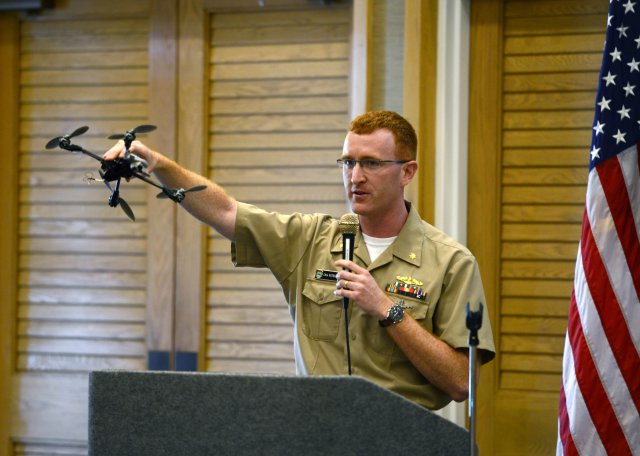
Man-overboard, man-overboard, man-overboard, port side,” is announced across the Navy over ship’s intercom systems and is a signal for Sailors and Marines to quickly transit to their muster stations as search and rescue teams prepare to deploy for recovery.
According to the Naval Safety Center, since 2006 more than 110 Sailors and Marines have fallen overboard, and 8 lost their lives.
Operating during rough seas and low visibility increases the risk of someone going overboard, and at the same time, is the most difficult time to maintain a visual on the Sailor.
“Being on the sail of a sub during a night transit in stormy weather made me think about what if someone were to fall overboard, how hard would it be turn around and find them,” said Lt. Cmdr. Christopher Keithley, attached to Commander, Submarine Force, U.S. Pacific Fleet (SUBPAC). “As a submarine officer I have done numerous man-overboard drills at sea where I gained an appreciation for the difficulty in keeping track of low profile objects in even the calmest of seas. It was this background that I brought to one of our innovation Lab [iLab] events where the discussion of Unmanned Aerial Vehicles (UAVs) occurred.”
According to Keithley, iLab is an unclassified space to prototype current commercial technologies to generate ideas for low-cost solutions to fleet training and operational challenges.
iLab is part of The Bridge Program, a Pacific Fleet owned program, that encourages innovation by providing Sailors of all paygrades an avenue to pitch ideas to top Navy officers and is intended to improve procedures and equipment used in the fleet.
“My UAV concept isn’t meant to replace current man-overboard procedures but work with them,” said Keithley. “Because of this program, I was able to present my idea and hopefully contribute to solving this challenge.”
During the initial proof of concept pilot program event, which ran from December 2015 – February 2016, Keithley and his team from iLab came together to develop their plan and pitch their idea.
“I may have started the conversation but the idea germinated after back and forth discussions with innovative members of the SUBPAC staff and demonstrations of technology displayed in our iLab,” said Keithley. “After seeing what UAVs and current camera technologies were capable of, I thought of how relatively easy it could be to create a man-overboard spotter UAV which could help recovery vessels vector in on Sailors in the water. I know that I, for one, would have loved to have as much cuing information as possible to help a shipmate adrift during an overboard recovery.”
His team consisted of Geoff Moss, SUBPAC science advisor, Chris Bretz, SUBPAC innovation advisor, Ted Ralston, director of Unmanned Aerial Systems at the Applied Research Laboratory at the University of Hawai’i, who provided the UAV for both the demonstration and prop for the pitch.
During a live 3-hour rapid innovation workshop in February called “The Pitch,” Keithley and his team presented their idea to a panel of mentors, or “Lookouts.” Their UAV idea was one of 8 pitches presented that day.
“The Bridge is encouraging because it shows great ideas can go somewhere,” said Keithley. “A lot of times, Sailors come up with great ideas but they go nowhere, but being able to see your idea moving forward and being heard; seeing the visibility and possible development of your idea is pretty amazing.”
Keithley and his team’s UAV idea was selected as one of the four ideas to move on to the annual U.S. Pacific Command Pacific Operational Science & Technology (POST) conference the following month and spent the following two weeks refining their idea and prototype, meeting with mentors and practicing their pitch.
At POST, they presented their idea to senior officers and executives from commands throughout the Pacific and were selected as the winning idea to be presented at the next PACFLT Commander’s Conference in June. The PACFLT “Bridge” team will use the feedback provided at POST and the Commander’s Conference to move his idea towards reality.
“I’m grateful for this opportunity and hope one day I can see the man-overboard UAV used on every ship and submarine that operate in open water,” said Keithley.
Since its establishment in 2016, The Bridge program has developed four ideas that are currently being used in the fleet: Cyber Impact Assessment (CYBERIA), a multi-stage analysis algorithm tool for cyber forensics; Polar Plot Whiz Wheel, a decision aide for preventing swamping low freeboard flight decks based on guidance published in the Naval Air Training and Operating Procedures Standardization (NATOPS); Entrepreneurship Bootcamp, a course offered to forward-leaning ambitious shipmates; and a pilot internship program funded by Message Digest algorithm 5 (MD5) National Security Technology Accelerator which gave four Sailors an opportunity to participate in an internship offered by Telos Corp to college students.
Photo: FORT SCHAFTER, Hawaii (March 9, 2017) Lt. Cmdr. Christopher Keithley, assigned to commander, Submarine Force, U.S. Pacific Fleet, pitches his idea about a new use for unmanned Aerial Vehicles to a panel of judges during the Pacific Operational Science and Technology (POST) Conference as part of U.S. Pacific Fleet’s “The Bridge” program at the Hale Ikena conference and banquet center in Fort Shafter, Hawaii. (U.S. Navy photo by Mass Communication Specialist 1st Class Phillip Pavlovich/Released)
Source: America’s Navy
